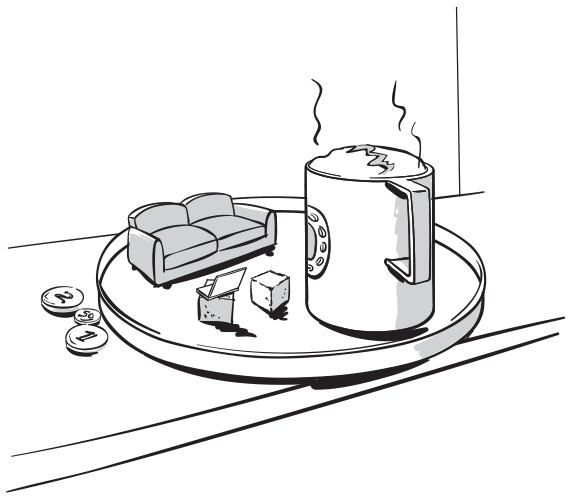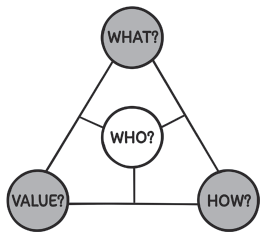Experience Selling
Products appealing to the emotions

The pattern
In the Experience Selling model, the value of a product or service is increased by an additional experience offered with it. For example, a bookstore may provide a range of features such as coffee areas, celebrity book signings and workshops to create a fuller experience. This business model is closely connected to marketing. Over and above designing products or services, experiences and impressions are created, going beyond offering just another undifferentiated product within a saturated market and, instead, providing customers with an encompassing experience rather than simply product functionality (WHAT?). The intention of this model is for the company to actively shape its customers’ observable environment, thus differentiating it from its competitors. The successful sale of experiences makes customers more loyal, and willing to buy more at a higher price, given that the related experiences are included (VALUE?). Experience Selling requires managing all activities affecting customers’ experiences in concert: these will include promotions, retail design, sales personnel, product functionality, availability and packaging (HOW?). It is also important that customers obtain the same experience, regardless of which branch of the business they deal with (HOW?).

The origins
The Experience Selling pattern was described in detail by Pine and Gilmore in their 1998 book The Experience Economy. The authors reference Alvin Toffler’s Future Shock, which, back in 1970 at the time of the Cold War, recognised that future consumers of the ‘experiential industry’ would increasingly spend their money on unusual positive experiences. The German sociologist Gerhard Schulze left his mark on Experience Selling theory when he coined the term Erlebnisgesellschaft (‘thrill-seeking society’) in 1992, and later Rolf Jensen contributed to the subject, speaking of the ‘dream society’.
Harley-Davidson, the well-known American motorcycle company founded in 1903, fully embraced the Experience Selling concept. The film Easy Rider (1969) presented an excellent opportunity for the company to associate the feeling of unbridled freedom with the Harley-Davidson brand. Philip Morris’s cigarette brand Marlboro employs similar associations of boundless freedom and adventure, embodied in the smoking ‘Marlboro Man’ cowboy, to sell its products.
One of the pioneers of Experience Selling is Restoration Hardware. Founded in 1980, this chain sells timeless, updated classics and authentic reproductions of historic furniture and home décor. Customers become immersed in the comfort and quiet nostalgia that permeates Restoration Hardware stores, evoking their desire to live a simple life in an ever-more complex world.
The innovators
Based in Seattle, Washington, Starbucks is a coffeehouse chain that currently operates over 30,000 outlets globally. Starbucks’ stores provide a range of food and beverages including coffee, pastries, snacks, teas, sandwiches and packed-food items. Its coffees also include more ‘gourmet’-type drinks, such as caffè latte and iced coffee. In addition, Starbucks offers a series of features, products and services that together make up the unique Starbucks experience (e.g. Wi-Fi, relaxing music, a cosy atmosphere and comfortable furniture). By adopting the Experience Selling model and offering many unique features besides coffee, Starbucks has gained in popularity and customer loyalty – ultimately leading to increased revenue.
Experience Selling: transforming coffee beans into lifestyle

Another example of Experience Selling is Red Bull, an Austrian company founded in 1987 and known for its energy drink of that name – the most popular of its kind in the world. The product is heavily marketed throughout the world with the distinctive Red Bull branding, targeted towards young males, with a prominent marketing campaign associated with active lifestyles and extreme sports such as Formula One, motocross, windsurfing, BMX and snowboarding. Like no other company, Red Bull supports extreme flying events such as Felix Baumgartner’s jump from the stratosphere, or unusual events such as boxcar races. These associations complement the Red Bull ‘experience’, encouraging people to engage in the lifestyle themes as well as the drink itself. Red Bull is able to charge higher prices for its products because customers want the entire experience, and not just the drink.
The potential of Experience Selling has also been recognised by online retailers, who increasingly have started to set up stationary stores in addition to their online shops. These stationary stores usually differ from classic stores through the offering of digital services. At the end of 2015, Amazon opened its first stationary bookstores in the USA, and in 2018, the first public Amazon Go grocery store. In contrast to traditional supermarkets, Amazon advertises that a short scan of one’s smartphone at the store entrance is enough to leave the store without physical payment. The entire payment process is handled digitally using a virtual shopping cart, which registers the customer’s removed and returned products. Customers are increasingly demanding that companies focus on the experience instead of the sales channel, and combine digital and analogue shopping to provide an integrated customer journey.
Founded in 2014, NIO is a rising star in the electrical mobility industry that collected more than US $4 billion in investment capital following the principle of Experience Selling. A Chinese company that focuses solely on the electrical car industry, NIO approaches customers differently from its competitors. While car manufacturers such as BMW are building heavily on their manufacturing capabilities, NIO has created a whole lifestyle ecosystem around its products: everyday products such as umbrellas, private coffee lounges at top venues, or its artificial intelligence system NOMI. Becoming a ‘member’ of the exclusive NIO community by purchasing one of its electrical cars, customers gain access to the NIO facilities and lifelong car maintenance services. Combined in the so-called NIO ‘house’, customers can attend conferences, enjoy a coffee break, access meeting rooms or the library, use the childcare service and bring their cars for maintenance or upgrade services. With currently three electrical SUV car models on the market, NIO is only active in China, but had already sold around 20,000 cars in July 2019, after its production start in autumn 2018.
When and how to apply Experience Selling
The retail industry has done exceptionally well with Experience Selling. Retailers no longer sell products; they are in a tug of war to win the hearts of customers. Experience Selling presents a major step towards achieving just that. You can differentiate yourself from your competitors and forge a direct bond with your customers by providing a holistic experience. Customers want to spend more time and money at your stores, as well as visit them more frequently.
Some questions to ask
- How can we create experiences for customers that truly reflect what our brand stands for?
- How will we get everyone in our company on the Experience Selling bandwagon?
- How do we create an emotional connection along the customer journey?
- How do we clearly define the experience our product offers?
- How can we create positive emotions and actually convert them into purchases?
